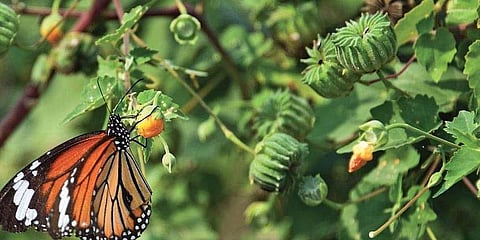
- LIFESTYLE
- FASHION
- FOOD
- ENTERTAINMENT
- EVENTS
- CULTURE
- VIDEOS
- WEB STORIES
- GALLERIES
- GADGETS
- CAR & BIKE
- SOCIETY
- TRAVEL
- NORTH EAST
- INDULGE CONNECT

In a concrete jungle such as Delhi, biodiversity parks—an amalgamation of different ecosystems such as forests, wetlands, and grasslands—are constructed to aid in conserving the fauna in urban spaces. The Capital is teeming with diverse species of birds and insects that need to be documented in order to conserve them. Keeping this in mind, the Biodiversity Parks Programme (BPP) of Delhi Development Authority (DDA) often conducts studies so as to document the insect faunas, especially the butterflies, in the city. Prominent members of the insect diversity—it makes up more than 50 per cent of the global biodiversity—butterflies provide major service to the ecosystem by being primary pollinators to plants.
A study to conserve winged wonders
A recent field study—it was conducted by the DDA Biodiversity Parks of Delhi—to assess the butterfly biodiversity in the city, identified 71 species of butterflies. This week-long exercise was conducted in the seven Biodiversity Parks of the city—Yamuna, Aravalli, Tilpath Valley, Northern Ridge (Kamla Nehru Ridge), Neela Hauz, Tughlaqabad, and Kalindi. Led by the scientists of the DDA Biodiversity Parks, a number of volunteers joined to observe these butterflies between October 25 and 30. In groups of two to five, they conducted 15 nature trails, varying from 500m to 2km, every day from 10am to noon. A similar study will be conducted in around March next year to study the butterfly species migrating to the Capital during spring.
Chronicling these colourful insects
Of the 71 species, the most distinguished species include:
The study showed that the Psyche, a shy white butterfly, which is usually difficult to spot, has a strikingly high population at Northern Ridge Biodiversity Park. Moreover, the Bevan’s Swift, which was recorded for the first time in the Capital, is found in both the Yamuna Biodiversity Park (YBP) as well as in Aravalli Biodiversity Park.
A happy revelation for nature lovers
Mohammad Faisal, an entomologist at YBP, says, “When we first started working in YBP in 2002, there were only three butterfly species in the city. Now, in just six days [during the study] we recorded around 65 species [in YBP].” This study thus comes as a happy revelation of the steady increase in the number and density of butterflies in Delhi. Aisha Sultana, a wildlife ecologist who is part of the BPP, mentions that this is just the beginning of the conservation of the insect fauna. Along with biodiversity parks, she insists that citizens should also be equal facilitators in the process. “The host plants for butterflies are usually native and local plants; these are mostly considered as weeds and are often uprooted from gardens,” she says. Reducing the use of pesticides and not grooming green spaces is very important. “Collect native plants and let them grow wild. That is the best way to create an insect habitat,” she concludes.